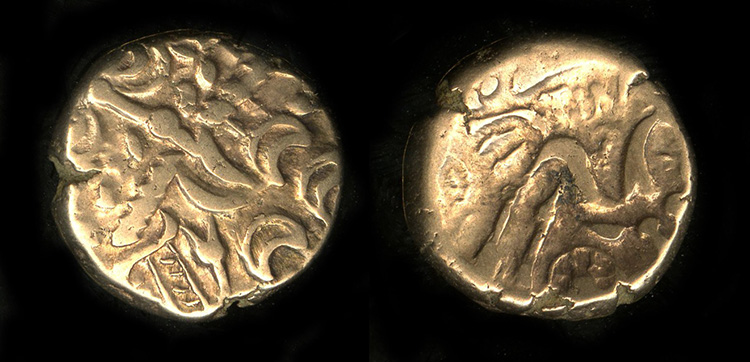(In fact, they arestill being discovered.)
The United Kingdom, in particular, is a hotbed for accidental finds and metal detector enthusiasts.
So, how did the British birder make his discovery?

Ancient coins on display at the British Museum; the Celtic coins recently discovered are likely to end up in similar museum contexts. (Photo:Stock Photosfrom CRISTINA.A/Shutterstock)
He was enjoying a fall walk when he stopped to observe a buzzard and magpies frolicking in a field.
Noticing something shiny on the ground, he picked up a hand-hewn (and clearly ancient) coin.
The machine instantly detected a large cache of metal not far below the surface.

Two sides of a gold coin, minted in England and excavated in Hampshire. The coin dates from about 20 BC to 10 CE. (Photo:© The Trustees of the British Museum[CC BY-NC-SA 4.0])
The man then dug down about 18 inches before he encountered a copper vessel full of ancient coins.
I had to sit down to get my breath back,he recalls.
I had only come out for a walk and found a Celtic hoard.

Boadicea (Boudica), queen of the British Celtic Iceni kingdom, died circa 60 or 61 AD. Imagined by John Opie for this 1793 engraving. (Photo:Wikimedia Commons[Public domain])
All finds of potential treasure trove must be reported to the proper authorities.
The mysterious man did just that by notifying his local coroner.
When finds of treasure or hoards are reported, the artifacts must be turned over for examination by experts.
If deemed to be an ancient treasure, the finds are offered for sale to museums.
The finder often receives part of the sale profit as a reward.
The coins found by the birder are especially historically important.
Experts believe these coinsknown as staterswere minted and likely buried during the reign of Boudica.
She reigned over the Celtic Iceni tribe whose lands covered modern-day Norfolk.
After her husbands’s death, the fierce leader led a rebellion against Britain’s Roman overlords.
According toTacitus, her forces killed about 70,000 Roman troops and sympathizers before she was brutally suppressed.
Historians believe the turbulence of her time may have led to increased hoarding during the first century CE.
Scientists hope to learn more about this fascinating period of Celtic history through the newly discovered coins.
A British birdwatcher discovered a Celtic Iron Age coin hoard in a field.
Two sides of a gold coin, minted in England and excavated in Hampshire.
The coin dates from about 20 BC to 10 CE.
Boadicea (Boudica), queen of the British Celtic Iceni kingdom, died circa 60 or 61 AD.
Imagined by John Opie for this 1793 engraving.